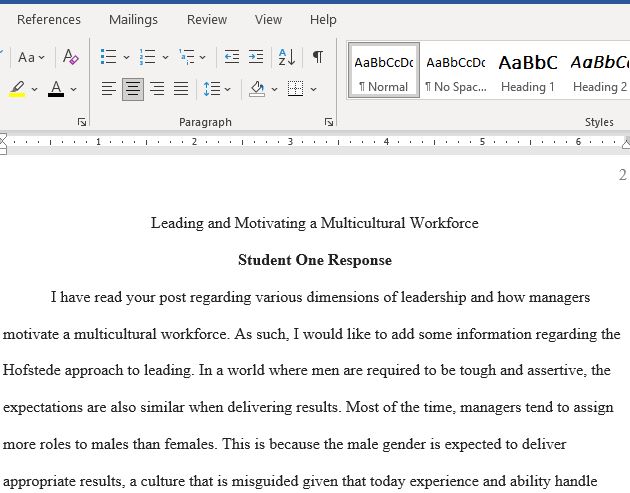Leading and Motivating a Multicultural Workforce
Title Leading and Motivating a Multicultural Workforce
Order description:
QUESTION: Choose one of the following leadership functions and contrast how these functions would most effectively be carried out according to one of Hofstede’s dimensions. Respond to BOTH student’s post below, by examining the same leadership function within a culture displaying another of Hofstede’s dimensions.
PLEASE REPLY TO BOTH STUDENTS RESPONSES BELOW!!
STUDENT ONE RESPONSE:
One of Hofstede’s dimensions of culture includes masculine/feminine culture, which in the business world can be referred to as a tough versus tender culture. (Hofstede, n.d). Within this culture, the expectation is for men to be tough, assertive, and more dominant in nature, and women are usually tender, modest, and more submissive in nature (Gill, 2017). This dimension of culture can become very one-sided in communicating within a business atmosphere and will heavily influence the way leaders handle resolving conflict.
There are five well-known conflict management styles that are used throughout society and as we examine these further, we can directly link them to resolving conflict in a masculine/feminine culture. These conflict management styles consist of accommodating, avoiding, compromising, competing, and collaboration (Valamis, n.d.). additionally, based on the culture defined, Turner (2017) discusses a continuum that contributes aggression and direct conflict to the masculine side, and indirect conflict and conflict avoidance to the feminine side of this cultural dimension.
The aggression in direct conflict shown ties into the conflict management style of competing, which is basically the masculine culture not giving in to the feminine side in order to remain tough and assertive to control the narrative. The indirect conflict and conflict avoidance tie into the conflict management styles of accommodating and avoiding. Which in this cultural worldview, the feminine side would either avoid the conflict altogether or be passive in resolving the conflict, leading to giving in to the will of the masculine entity.
This is important to understand from a cultural worldview because if put into a leadership role in a different culture, the organizational culture may experience this type of conflict resolution as well as many others not discussed here. Cultural awareness is the key ingredient to understanding how to integrate and operate in a multidimensional cultural working environment and Hofstede’s dimensions of culture are used to educate individuals and organizations on the differences that can be recognized on the path to self-awareness and CQ.
References
Gill, C. (2017, March 23). Hofstede’s cultural dimensions and differences across cultures. Oxford University Press Blog. Retrieved from https://blog.oup.com/2017/03/hofstede-cultural-dimensions/
Hofstede, G. (n.d). National culture. Geert Hofstede. Retrieved from https://hi.hofstede-insights.com/national-culture
Turner, C. (2017). ‘Masculine’ and ‘Feminine’ Styles of Handling Conflict. Retrieved from https://www.huffpost.com/entry/masculine-and-feminine-st_b_6633896
Valamis. (n.d.). Conflict Management Styles. Retrieved from https://www.valamis.com/hub/conflict-management-styles
STUDENT TWO RESPONSE;
Resolving conflict
When I was working in Fast Food some years ago, the DM had brought in a shift manager from another store. After about three weeks, we found out why he was placed in our store. He had several problems, one is power distance, and he felt he was in charge, even when it was not his shift. He would change the way things were done faster to the way he liked it, or he would jump in and start telling crew even other managers what to do, when it was not his shift. One problem he had was the degree of power distance and he could not equalize the distribution of power with other managers, even when it was not his shift to run. This would also fall under individualism versus collectivism. He did not share power. He came in and took over, even on his days off (Hofstede Insights).
Our GM wanted him gone, however the DM thought he would change. I will not say where he was from, however in his culture men were dominant and he would do things that here we would think it would be wrong. I think this is why the DM did not let him go. He was trying to get him to work the way we do in here the US. This young man and I almost came to blows several times. I ran the store by the book and everything ran smoothly. No words could be used, on how he did things; the only way to resolve the conflict was have him moved to his fourth store.
All managers there had conflicts with the way others would do things, however we were all professional and would resolve our conflicts in our weekly meeting. We learned to work as a team, that is why our store had the best times in drive through and made more money that the other stores.
References
Hofstede Insights (2020) National Culture Retrieved from https://hi.hofstede-insights.com/national-culture
Answer Preview For Leading and Motivating a Multicultural Workforce
Access the full answer containing 623 words by clicking the below purchase button

